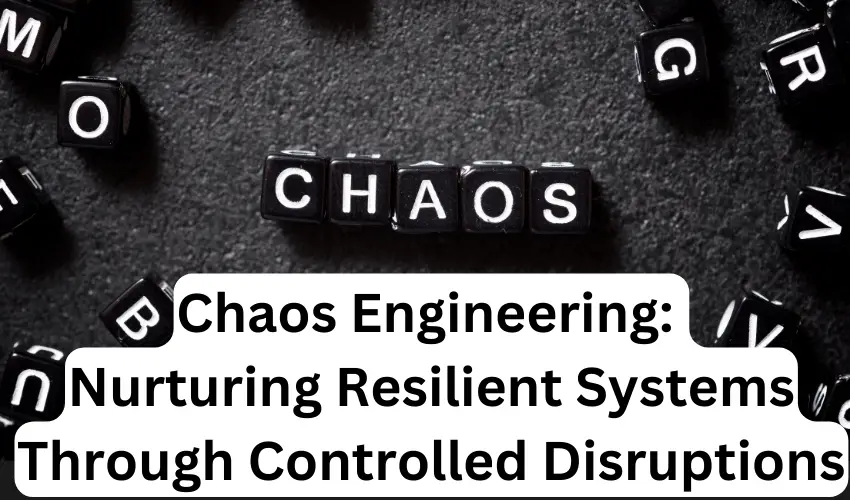In the rapidly evolving landscape of technology, where systems are becoming increasingly complex and interdependent, ensuring the resilience of applications has become paramount. Chaos Engineering, a discipline pioneered by companies like Netflix, has emerged as a vital strategy to proactively identify weaknesses in systems before they lead to widespread outages.
In this article, we delve into the depths of Chaos Engineering, exploring its principles, methodologies, and the pivotal role it plays in modern DevOps practices.
Also check: Linuxtechlab DevOps Homepage
Understanding Chaos Engineering
At its core, Chaos Engineering is the practice of intentionally introducing controlled, disruptive events into a system to uncover vulnerabilities and weaknesses. Unlike traditional testing, which focuses on ensuring that things work as expected, Chaos Engineering is about understanding how things behave when they don't. By simulating real-world failures, engineers can gain valuable insights into system behavior under adverse conditions, enabling them to build more resilient architectures.
To harness the power of Chaos Engineering and ensure the resilience of your systems, consider hiring a skilled DevOps engineer from Lemon.io: https://lemon.io/hire-devops-engineers/.
Principles of Chaos Engineering
Chaos Engineering operates on several key principles:
- Define “Steady State”: Chaos experiments begin by defining a system’s normal operating conditions, known as the “steady state.” This encompasses metrics like response times, error rates, and resource utilization.
- Hypothesize: Engineers develop hypotheses about how the system should behave. For instance, if a database server fails, the system should seamlessly switch to a backup without disrupting user experience.
- Introduce Chaos: Controlled experiments are conducted, introducing chaos into the system. This can involve shutting down servers, increasing network latency, or simulating sudden spikes in traffic.
- Monitor and Analyze: Throughout the chaos experiment, the system's behavior is closely monitored. Metrics and logs are analyzed to understand how the system responds to disruptions.
- Learn and Iterate: Based on the experiment’s outcomes, teams learn from both successes and failures. This knowledge is used to improve the system’s design, making it more resilient to future failures.
The Benefits of Chaos Engineering
Implementing Chaos Engineering offers several advantages to organizations:
- Enhanced Resilience: By identifying and addressing weaknesses proactively, systems become more resilient to unexpected failures, ensuring uninterrupted services for users.
- Increased Confidence: Chaos Engineering builds confidence among development and operations teams. Knowing how the system behaves under stress allows for better decision-making during incidents.
- Cost-Effective Issue Identification: Chaos Engineering helps in uncovering issues in a controlled environment, reducing the costs associated with real-time outages and downtime.
- Improved Customer Experience: Resilient systems translate to better user experiences. Users experience fewer disruptions and faster recovery times in the event of failures.
- Cultural Shift: Chaos Engineering promotes a culture of continuous improvement and learning within organizations. It encourages collaboration, communication, and innovation.
Challenges and Best Practices
While Chaos Engineering offers substantial benefits, its implementation comes with challenges. Organizations must strike a balance between introducing controlled disruptions and ensuring the stability of critical systems. This requires careful planning, collaboration, and adherence to best practices.
- Start Small: Begin with small, well-defined experiments before progressing to more complex scenarios. This gradual approach allows teams to learn and adapt without risking major system failures.
- Collaboration is Key: Chaos Engineering involves multiple teams, including developers, operations, and QA. Effective communication and collaboration are essential to the success of chaos experiments.
- Automate Experiments: Automating chaos experiments ensures consistency and reproducibility. Tools like Chaos Monkey and Gremlin provide automation capabilities, making it easier to conduct experiments in diverse environments.
- Embrace Failure: Chaos Engineering is about embracing failure as a learning opportunity. When experiments reveal vulnerabilities, they should be seen as valuable insights, leading to system improvements.
- Document and Share: Documenting chaos experiments and their outcomes is crucial. Sharing this knowledge across teams fosters a culture of shared learning and accelerates the organization’s ability to respond to failures.
Conclusion
In the ever-changing digital landscape, Chaos Engineering stands as a powerful tool in the hands of DevOps professionals. By intentionally introducing controlled chaos into systems, organizations can uncover weaknesses, enhance resilience, and ultimately provide superior user experiences. As technology continues to advance, the principles of Chaos Engineering will remain integral, guiding the development of robust, fault-tolerant systems in an unpredictable world.
Through meticulous experimentation and continuous learning, businesses can not only survive chaos but thrive in the face of it, ensuring their systems are always prepared for whatever challenges the future may bring.
We are giving you exclusive deals to try Linux Servers for free with 100$ credit, check these links to claim your 100$,
DigitalOcean - 100$ free credit & Linode - 100$ free credit
Check some Exclusive Deals, HERE.
Also, check out DevOps Book You should read section.
